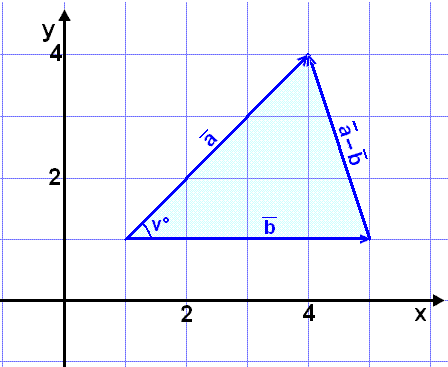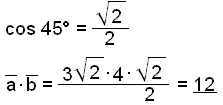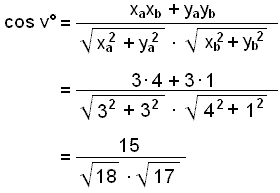© 2008 Rasmus ehf and Jóhann Ísak
|
© 2008 Rasmus ehf and Jóhann Ísak |
Vectors |
|
Scalar product and perpendicular vectors
How
can we find the angle between two vectors? The Cosine Rule looks promising as we
can use it to find the angle between two sides of a triangle. (See lesson 3 on
triangles). We can make a triangle out of the two vectors ![]() and
and
![]() ,
and a third vector
,
and a third vector
![]() −
−
![]() (see
lesson 1 on vectors 1). Look at the diagram below.
(see
lesson 1 on vectors 1). Look at the diagram below.

In this example it’s easy to find the vectors by counting the squares, but we will use the general form for any vector:
![]()
The Cosine Rule is as follows:
c 2 = a 2 + b 2 − 2∙b∙a∙cos C
The
sides of the triangle have lengths |![]() |,
|
|,
|![]() |
and |
|
and |![]() −
−
![]() |.
If we label the triangle so that side a = |
|.
If we label the triangle so that side a = |![]() |,
b = |
|,
b = |![]() |
and c = |
|
and c = |![]() −
−
![]() |
and label angle C as v° we get:
|
and label angle C as v° we get:
|![]() -
- ![]() |2
= |
|2
= |![]() |2
+ |
|2
+ |![]() |2
- 2∙|
|2
- 2∙|![]() |∙
|
|∙
|![]() |∙cos
v°
|∙cos
v°
Now we can use the distance formula to find the length of the vectors. We can leave out the square root as we are squaring the lengths.
(xa − xb)2
+ (ya − yb)2 = xa2
+ ya2 + xb2
+ yb2 −
2∙|![]() |∙
|
|∙
|![]() |∙cos
v°
|∙cos
v°
If we simplify the left hand side by multiplying out the brackets it becomes:
xa2 − 2xaxb + xb2 + ya2 − 2yayb + yb2
Putting this in the formula we see that all the squared terms cancel out and we are left with the equation
−
2xaxb − 2yayb
= − 2∙|![]() |∙
|
|∙
|![]() |∙cos
v°
|∙cos
v°
Dividing through by −2 we get the following important formula:
|
xaxb
+ yayb =
| |
Each side of this equation is called the Scalar Product of two vectors. In other words:
The
scalar product of
![]() and
and
![]() =
xaxb + yayb and
=
xaxb + yayb and
the scalar product of
![]() and
and
![]() =
|
=
|![]() ||
||![]() |cos
v°
|cos
v°
The symbol for scalar product is a point similar to the symbol sometimes used for multiplication. Its very important to distinguish between the two. A dot written between two vectors is always the scalar product. In fact it is often called the Dot Product. Using this notation we can write:
![]() ∙
∙
![]() = xaxb
+ yayb and
= xaxb
+ yayb and
![]() ∙
∙
![]() = |
= |![]() |∙
|
|∙
|![]() |∙cos
v°
|∙cos
v°
Write the scalar product of the vectors
![]() and
and
![]() in
the following diagram in two different ways.
in
the following diagram in two different ways.

We
can read the coordinates of the vectors directly from the diagram. We can also
see the length of the vector
![]() but
we need to calculate the length of vector
but
we need to calculate the length of vector
![]() .
.
Using coordinates to find the scalar product:
|
|
The x coordinates are multiplied together, the y coordinates multilpied together and then the two outcomes are added together . |
Using the other definition of scalar product with vector lengths and cosine we get:
|![]() |
=
|
= ![]()
|![]() |
= 4
|
= 4

Now we will answer the question we set out with and see how we can find the
angle between two vectors.
To do this we use both forms of the scalar product.
xaxb + yayb
= |![]() |∙
|
|∙
|![]() |∙cos
v°
|∙cos
v°
Dividing through by
|![]() ||
||![]() |
we get the following formula:
|
we get the following formula:
 |
If we use the distance formula to find the lengths this becomes:
 |
Find the angles between the vectors ![]()

≈ 0.8575
v° ≈ cos−1 0.8575 ≈ 31°
Find a vector that is the same length as
![]() and
perpendicular to
and
perpendicular to
![]() .
.
We call this vector
![]() and
write the formula for the scalar product of
and
write the formula for the scalar product of
![]() and
and
![]() .
.
xaxb + yayb
= |![]() |∙
|
|∙
|![]() |∙cos
90°
|∙cos
90°
![]()
But cos 90° = 0 so we get the following result:
x + 2y = 0
We also know that |![]() |2
= x2 + y2 = 5.
|2
= x2 + y2 = 5.
Solving these two equations together we get , x + 2y = 0 and x2 + y2 = 5.
x = −2y and x2 = 5 − y2
x2 = 4y2 = 5 − y2
5y2 = 5
y2 = 1
y = ±1
If y = 1 then x = −2 and if y = −1 then x = 2.
This means we have two possibilities
![]()
Drawing the diagram we see these two outcomes.

Generalising the above results we see that we can find two vectors that are perpendicular to each other and of the same length by switching round the x and y coordinates and changing the sign on one of the coordinates.
|
The vector
|
This is because the angle between perpendicular vectors is 90° and cos 90º = 0
|
If the
vector
|
The converse of this rule is also true.
|
If the scalar product of two vectors is zero then they are perpendicular to each other. |
Triangle ABC has vertices A = (–3, –4), B = (17, –12) and C = (5, 16). Find the angles of the triangle.
First we find vectors that represent the sides.
![]()
![]()
We don’t need to do any more work as the vectors
![]() and
and
![]() are
obviously perpendicular and equal in length. The triangle is therefore a right
angled isosceles triangle with angle A = 90º, B = 45º and C = 45º.
are
obviously perpendicular and equal in length. The triangle is therefore a right
angled isosceles triangle with angle A = 90º, B = 45º and C = 45º.
Triangle ABC has vertices A = (–3, –3), B = (21, 7) and C = (4, 14).
a) Find the angle A
First find the vectors
![]() and
and ![]() .
.
![]()
![]()
Now find their lengths.
Finally we find the angle A, between
and
.
M
ultiply by Ö2 above and below the fraction lineb) Find the height from C onto the side AB.
sin A = h/|
|
h = |
| · sin A
= 13·Ö2·Ö2/2
= 13
c) Find the vector
from C to AB, perpendicular to AB.
The vector
is perpendicular to
and twice as long. We can therefore find
by turning
through 90º and dividing the coordinates by 2.
Try Quiz
4
on Vectors.
Remember to use the checklist to keep track of your work.